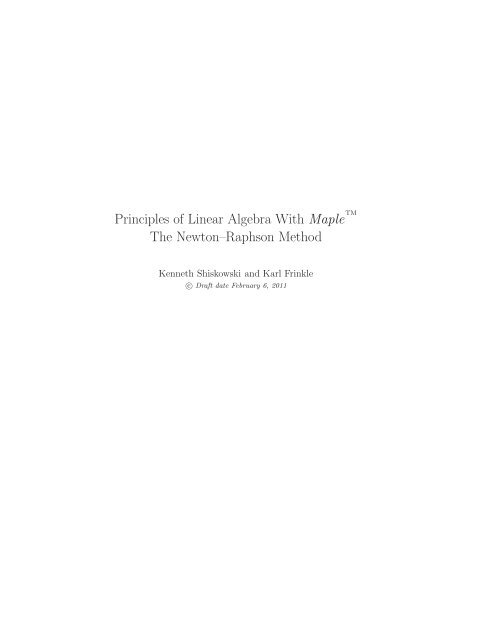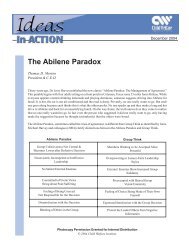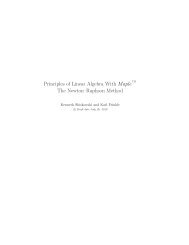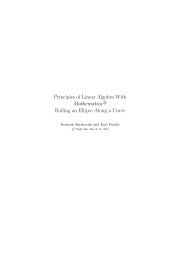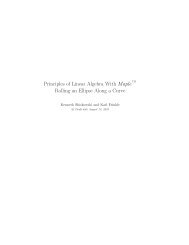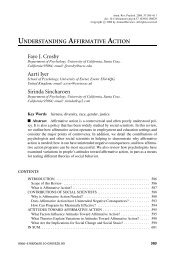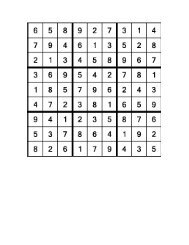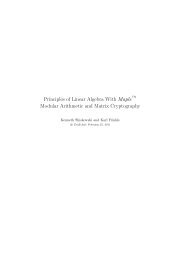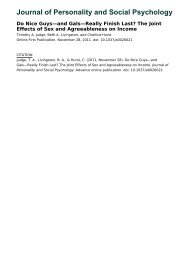Principles of Linear Algebra With Maple The NewtonâRaphson ...
Principles of Linear Algebra With Maple The NewtonâRaphson ...
Principles of Linear Algebra With Maple The NewtonâRaphson ...
- No tags were found...
Create successful ePaper yourself
Turn your PDF publications into a flip-book with our unique Google optimized e-Paper software.
<strong>Principles</strong> <strong>of</strong> <strong>Linear</strong> <strong>Algebra</strong> <strong>With</strong> <strong>Maple</strong> TM<strong>The</strong> Newton–Raphson MethodKenneth Shiskowski and Karl Frinklec○ Draft date February 6, 2011
Contents1 <strong>The</strong> Newton-Raphson Method for a Single Equation 11.1 <strong>The</strong> Geometry <strong>of</strong> the Newton-Raphson Method . . . . . . . . . 11.2 Examples <strong>of</strong> the Newton-Raphson Method . . . . . . . . . . . . 101.3 An Example <strong>of</strong> When the Newton-Raphson Method Does theUnexpected . . . . . . . . . . . . . . . . . . . . . . . . . . . . . 162 <strong>The</strong> Newton-Raphson Method for Square Systems<strong>of</strong> Equations 192.1 Newton-Raphson for Two Equations in Two Unknowns . . . . 192.2 Newton-Raphson for Three Equations in Three Unknowns . . . 28v
Chapter 1<strong>The</strong> Newton-RaphsonMethod for a SingleEquation1.1 <strong>The</strong> Geometry <strong>of</strong> the Newton-RaphsonMethodIn studying astronomy, Sir Isaac Newton needed to solve an equation f(x) = 0involving trigonometric functions such as sine. He could not do it by anyalgebra he knew and all he really needed was just a very good approximationto the equation’s solution. He then discovered the basic algorithm called theNewton-Raphson Method althoughNewtonfounditinapurelyalgebraicformatwhich was very difficult to use and understand. <strong>The</strong> general method and itsgeometric basis was actually first seen by Joseph Raphson (1648 - 1715) uponreading Newton’s workalthough Raphson only used it on polynomial equationsto find their real roots.<strong>The</strong> Newton-Raphson method is the true bridge between algebra (solvingequations <strong>of</strong> the form f(x) = 0 and factoring) and geometry (finding tangentlines to the graph <strong>of</strong> y = f(x)). What follows will explore the idea <strong>of</strong> theNewton-Raphson Method and how tangent lines will help us solve equationsboth quickly and easily although not for exact solutions, only approximateones.<strong>The</strong> reason that we are studying the Newton-Raphson Method in this bookis that it can also solve square non-linear systems <strong>of</strong> equations using matricesand their inverses as we shall see later. It is part <strong>of</strong> the wonderful effectiveness<strong>of</strong> the Newton-Raphson Method in that it can solve either a single equationor a square system <strong>of</strong> equations for its real or complex solutions, but only1
2 Chapter 1. Newton-Raphson Method for a Single Equationapproximately although to as many decimal places as you want.Nowwe will discussthe important application<strong>of</strong>usingtangent lines tosolvea single equation <strong>of</strong> the form f(x) = 0 for approximate solutions either real orcomplex.Example 1.1.1. <strong>The</strong> best way to understand the simplicity <strong>of</strong> this methodand its geometric basis is to look at an example. Let’s say that we want tosolve the equationx 3 −5x 2 +3x+5 = 0 (1.1)for an approximate solution x. We can easily estimate where the real solutionsare by finding the x-intercepts <strong>of</strong> the graph <strong>of</strong> y = x 3 −5x 2 +3x+5. Rememberthat the total number <strong>of</strong> real or complex roots to any polynomial is its degree(or order) which in this case is three. Also, when a polynomial has all realcoefficients as this one does all <strong>of</strong> the complex roots (if there are any) occurin complex conjugate pairs. This particular polynomial has exactly three realroots and no complex roots by looking at its graph below.> with(plots): with(plottools):> f:= x -> xˆ3 - 5*xˆ2 + 3*x + 5:> roots f:= [fsolve(f(x), x, complex)];roots f := [−0.7092753594,1.806063434,3.903211926]> plot xintercepts:= seq(circle([roots f[j],0], .3, color = blue), j=1..3):> plotf:= plot(f(x), x = -3..7, thickness = 2):> display({plotf, plot xintercepts}, view = [-3..7,-4..6]);6y42–2 2 4 6x–2–4Figure 1.1: <strong>The</strong> three roots <strong>of</strong> the polynomial x 3 −5x 2 +3x+5 are its threex-intercepts (circled)
1.1 Geometry <strong>of</strong> the Newton-Raphson Method 3Figure 1.1 clearly shows that our equation has three real solutions, with anegative one near x = −1 and two positive ones near x = 2 and x = 4. Let’stry to approximate the one near x = 4 as accurately as we can.First, let’s see what fsolve will give us for just the solution near x = 4. Ithas given us all the roots <strong>of</strong> this polynomial above if we use the complex option.fsolve usesmanyalgorithmssimilartoandincludingtheNewton-Raphsonmethod in combination to approximate solutions both to a single equation ora square system <strong>of</strong> equations.> fsolve(f(x), x, 3.5..4.5);3.903211926<strong>The</strong> idea that Raphson had was to take a value <strong>of</strong> x near x = 4, say x = 5,andput in thetangentline tothegraph<strong>of</strong>ourfunction f(x) atx = 5. Thistangentline goes through the point (5,f(5)) = (5,20) and has slope df (5), wheredxdfis the derivative function <strong>of</strong> f(x). Now <strong>Maple</strong> can easily compute both f(5)dxand df (5). <strong>The</strong> unapply command converts the expressions “diff(f(x), x)” intodxthe derivative function df(x).> f(5);> diff(f(x),x);> df:= unapply(diff(f(x),x),x);> df(5);203x 2 −10x+3df := x → 3x 2 −10x+328So the slope <strong>of</strong> the tangent line to the graph <strong>of</strong> y = f(x) at the point (5,20)is 28 and the equation <strong>of</strong> this tangent line at x = 5 is y−f(5) = dfdx (5)(x−5)or y = 28x−120. Let’s now graph together this tangent line and the originalfunction f(x).> plot guess:= arrow([5,-10], [5,-4.5], .03, .15, .2, color = gold):> plot xint:= arrow([30/7,-10], [30/7,-4.5], .03, .15, .2, color = blue):> plot soln:= arrow([3.9,10], [3.9,2], .03, .15, .2, color = red):> plotfwithtang:= plot([f(x), 28*x - 120], x = 3.5..5.5, color = [red, blue],thickness = [3,2]):
4 Chapter 1. Newton-Raphson Method for a Single Equation> display({plot guess, plotfwithtang, plot xint, plot soln});y2004 4.5 5 5.5x–20Figure 1.2: Tangent line to our polynomial at x = 5Uponinspection<strong>of</strong>Figure1.2, notethatthetangentlineatx = 5crossesthex-axis much closer to our solution near x = 4 than our very rough estimate <strong>of</strong>x = 5forthe placement<strong>of</strong>thistangentline. <strong>The</strong> x-intercept<strong>of</strong>this tangentlineis the solution for x to the tangent line’s equation y = f(5)+ dfdx (5)(x−5) = 0which isx = 5− f(5)dfdx (5)(1.2)= 307 ≈ 4.285714286So x-intercepts <strong>of</strong> tangent lines seem to move you closer to the x-intercepts<strong>of</strong> their function f(x). This is what Raphson saw which Newton did not seebecause Newton forgot to look at the geometry <strong>of</strong> the situation and instead heconcentrated on the algebra.Raphson’s next idea was to try to move even closer to the root <strong>of</strong> f(x) (thex-intercept <strong>of</strong> y = f(x) or solution to f(x) = 0) by repeating the tangent line,but now at the point given by this new value <strong>of</strong> x = 4.285714286 which is thex-intercept <strong>of</strong> the previous tangent line. Let’s do it repeating the above workand see if Raphson was correct to do this. Let’s now call our starting guessnear the root by x 0 = 5 and the x-intercept <strong>of</strong> the tangent line at x = 5 byx 1 = 4.285714286. <strong>The</strong> value <strong>of</strong> x 1 is definitely closer to the root than thestarting guess x 0 .> x0:= 5.:> x1:= x0 - f(x0)/df(x0);x1 := 4.285714286
1.1 Geometry <strong>of</strong> the Newton-Raphson Method 5> f(x1);> df(x1);> f(x1) - x1*df(x1);4.7376093415.24489796−60.59766764So the slope <strong>of</strong> the tangent line to the graph <strong>of</strong> y = f(x) at the point(x 1 ,f(x 1 )) = (4.285714286,4.73760934) is 15.24489796 and the equation <strong>of</strong>this tangent line at x = x 1 isory −f(x 1 ) = dfdx (x 1)(x−x 1 )y = f(x 1 )+ dfdx (x 1)(x−x 1 )= 15.24489796x−60.59766764Let’s now graph (see Figure 1.3) together this tangent line and the originalfunction f(x).> plot xint2:= arrow([3.97495,-10], [3.97495,-4.5], .03, .15, .2, color = blue):> plot fwithtangs:= plot([f(x), 28*x - 120, 15.2449*x - 60.5977], x = 3.5..5.5,color = [red, blue, blue], thickness = [4,2,2]):> display({plot guess, plot fwithtangs, plot xint, plot xint2, plot soln}, view= [3.5..5.3, -15..30]);30y201004 4.5 5x–10Figure 1.3: Tangent lines at x = 5 and x = 4.28571
6 Chapter 1. Newton-Raphson Method for a Single EquationRaphson clearly has a very good idea in the use <strong>of</strong> tangent lines to approximatelysolve single equations <strong>of</strong> the form f(x) = 0 if our picture above is trulycorrect. Happily for both Raphson and us, this picture is right and successivetangent lines and their x-intercepts do move closerand closer to the x-intercept<strong>of</strong> their underlying function f(x).<strong>The</strong> general formula for the x-intercept <strong>of</strong> the tangent line to the graph <strong>of</strong>y = f(x) at the point where x = a issince the equation <strong>of</strong> the tangent line at x = a isIf you now solvex = a− f(a)dfdx (a) , (1.3)y = f(a)+ dfdx (a)(x−a)f(a)+ dfdx (a)(x−a) = 0for x, you will get equation (1.3).Let’s use this formula below to get the successive x-intercepts for thesetangent lines. <strong>The</strong> values <strong>of</strong> these x-intercepts are clearly moving towards theroot <strong>of</strong> our polynomial which is roughly at x = 3.9 on the x-axis below the redarrow in the above plots.<strong>The</strong> number <strong>of</strong> digits is now set to twelve instead <strong>of</strong> the default <strong>of</strong> ten sincewe want to get ten accurate digits when we round down to ten.> Digits:= 12:> x0:= 5.:> x1:= x0 - f(x0)/df(x0);> x2:= x1 - f(x1)/df(x1);> x3:= x2 - f(x2)/df(x2);> x4:= x3 - f(x3)/df(x3);x1 := 4.28571428571x2 := 3.97494740867x3 := 3.90652292594x4 := 3.90321950278
1.1 Geometry <strong>of</strong> the Newton-Raphson Method 7> x5:= x4 - f(x4)/df(x4);x5 := 3.90321192597> x6:= x5 - f(x5)/df(x5);x6 := 3.90321192590> x7:= x6 - f(x6)/df(x6);x7 := 3.90321192592This is the answer accurate to ten decimal places that fsolve gave us <strong>of</strong>x = 3.903211926. We perhaps got it the same way fsolve did since the Newton-Raphson Method is part <strong>of</strong> fsolve. To get this answer accurate to ten decimalplaces, it took only six repeated applications <strong>of</strong> the Newton-Raphson Method.This is a very fast procedure even when our starting guess <strong>of</strong> x = 5 is not veryclose to the root nearest to it.It should be noted that you stop the Newton-Raphson Method when youget a repetition in the value for two consecutive x-intercepts <strong>of</strong> your tangentlines accurate to the number <strong>of</strong> digits you desire. This is the reason we couldcould stop after we got x 6 since x 6 = x 5 accurate to ten digits.Newton’s Method will in general solve equations <strong>of</strong> the form f(x) = 0 forthe solution nearest a starting estimate <strong>of</strong> x = x 0 . It then creates a list <strong>of</strong>values x n where each x n (the nth element <strong>of</strong> this list) is the x-intercept <strong>of</strong> thetangent line to y = f(x) at the previous list value <strong>of</strong> x = x n−1 . This gives thegeneral formula for the x n <strong>of</strong>x n+1 = x n − f(x n)dfdx (x n)(1.4)starting with x 0 . Each x n is usually closer to being a solution to f(x) = 0 thanthe previous x n−1 . <strong>The</strong> x n can all be gotten from iterating the starting guessx 0 in the iteration functiong(x) = x− f(x)dfdx (x) (1.5)This means that x n+1 = g(x n ) for all n starting with 0.<strong>The</strong> method we are using is called iteration since it begins with a startingguess value <strong>of</strong> x 0 and then finds the iteration values x 1 ,x 2 ,... thereafter using
8 Chapter 1. Newton-Raphson Method for a Single Equationthe same formula g(x) based on the previous value. <strong>The</strong> function g(x) whichcomputes these iteration values is called the iterator.<strong>The</strong> following procedure will table some values <strong>of</strong> this Newton sequence<strong>of</strong> iterates from Example 1.1.1 and x 0 ’s near our three solutions which youmust provide as x 0 . We will carry out n = 8 iterations <strong>of</strong> the Newton-RaphsonMethod to generate the list <strong>of</strong> lists called newton. Try different list <strong>of</strong> values forx 0 to see how they affect the Newton list moving toward the solutions nearestthem. <strong>The</strong> starting list for x 0 below was chosen from the graphs above sothat the tangents at these points will intersect the x-axis towards the solutionnearest it. We stop iteratingwith the iteratorg(x) when twoconsecutivevaluesin the sequence <strong>of</strong> x n ’s are the same to the accuracy desired.Wewillusethethreestartingguessesforx 0 <strong>of</strong>0, 1, and5orthe list[0.,1.,5.]where the decimal point is used to tell <strong>Maple</strong> that we want decimal approximationsand not exact values since to <strong>Maple</strong> any number with a decimal point init is considered an approximation. <strong>With</strong>out these decimal points <strong>Maple</strong> wouldcompute exact values giving us horrendous fractions for the values <strong>of</strong> our iteratesinstead <strong>of</strong> decimal approximations.> Digits:= 12:> f:= x -> xˆ3 - 5*xˆ2 + 3*x + 5:> df:= unapply(diff(f(x),x), x);> x0:= [0., 1., 5.]:> n := 8:> g := unapply(x - f(x)/df(x), x);df := x → 3x 2 −10x+3g := x → x− x3 −5x 2 +3x+53x 2 −10x+3> newt:= proc(i) map(g, newt(i-1)) end:> newt(1):= x0:> newton:= [seq(newt(i), i = 1..n+1)];[[0.0,1.0,5.0],[−1.66666666667,2.0,4.28571428571],[−1.00529100529,1.80000000000,3.97494740867],[−0.751331029986,1.80606060606,3.90652292594],[−0.710320317972,1.80606343352,3.90321950278],[−0.709276029619,1.80606343353,3.90321192597],[−0.709275359437,1.80606343355,3.90321192590],[−0.709275359437,1.80606343352,3.90321192592],[−0.709275359437,1.80606343353,3.90321192589]]
1.1 Geometry <strong>of</strong> the Newton-Raphson Method 9> evalf(fsolve(f(x),x,complex),10);> evalf(newton[9],10);−0.7092753594,1.806063434,3.903211926[−0.7092753594,1.806063434,3.903211926]<strong>The</strong> evalf command has rounded the values in the list newton[9] to tendigits and it agrees to ten digits the results from fsolve. You have just seen theNewton-Raphson Method solve for the three real roots <strong>of</strong> our polynomial f(x)simultaneously working on finding each root based on three different startingguesses near them.<strong>The</strong> next section will continue looking at more examples <strong>of</strong> the uses <strong>of</strong> theNewton-Raphson algorithm. It will look for complex roots to polynomials,solve for thirteenth roots <strong>of</strong> numbers, find inverse trignometric function values.Before we conclude this section, let’s animate the tangent lines to our cubicpolynomial f(x) and see them moving along the polynomial’s graph. Thismight help you understand why the Newton-Raphson Method works geometricallyif you watch where these tangent lines’ x-intercepts are going. We willplot 101 tangent lines for equally spaced points from x = −2 to x = 6. Figure1.4 shows nine <strong>of</strong> the tangent lines from the animation.> f:= x -> xˆ3 - 5*xˆ2 + 3*x + 5:> plotf:= plot(f(x), x = -2.5..6.5, thickness = 3, color = red, view = -50..70):> df:= unapply(diff(f(x),x), x):> pts<strong>of</strong>tangency:= [seq(-2. + (6+2)/100*(K-1),K=1..101)]:> tangentlines:= [seq(f(pts<strong>of</strong>tangency[K]) + df(pts<strong>of</strong>tangency[K])*(x - pts<strong>of</strong>tangency[K]),K = 1..101)]:> plots<strong>of</strong>tanglines:=[seq(plot(tangentlines[K], x=-2.5..6.5,thickness=2, color= blue, view = -50..70), K=1..101)]:> display([seq(display(plotf, plots<strong>of</strong>tanglines[K]), K = 1..101)], insequence =true);y604020–2 02 x 4 6–20–40Figure 1.4: Nine frames in the tangent line animation, at x = −2,−1,...,5,6
10 Chapter 1. Newton-Raphson Method for a Single Equation1.2 Examples <strong>of</strong> the Newton-Raphson MethodIn this section, we will use the machinery developed in Section 1.1, we willapply the Newton-Raphson Method to specific problems.Example 1.2.1. As example <strong>of</strong> the power <strong>of</strong> Newton’s method, we will use itto find all the roots <strong>of</strong> the polynomial8x 5 −3x 4 +2x 3 +9x−5 (1.6)both realandcomplex, andthen tousethesefiverootst<strong>of</strong>actorthispolynomialcompletely. Since this polynomial has all real coefficients, the complex rootsoccur in complex conjugate pairs. This fact about the roots usually means weonly need find roughly half as many roots as the degree <strong>of</strong> the polynomial. Ifyou graph this polynomial (Figures 1.5 and 1.6) you will see that it probablyonly has one real root.Why does an odd degree polynomial with all real coefficients have to haveat least one real root? It is because there are going to be an even number<strong>of</strong> complex roots since they occur in complex conjugate pairs while the totalnumber <strong>of</strong> all the roots must be the degree <strong>of</strong> the polynomial which is odd.> Digits:= 10:> f:= x -> 8*xˆ5-3*xˆ4+2*xˆ3+9*x-5:> with(plots):> plot(f(x), x = -10..10);y500000x–10 –5 5 10–500000Figure 1.5: Graph <strong>of</strong> f(x) = 8x 5 −3x 4 +2x 3 +9x−5
1.2 Examples <strong>of</strong> the Newton-Raphson Method 11> plot(f(x), x = -3..3);y1000x–3 –2 –1 1 2 30–1000–2000Figure 1.6: Graph <strong>of</strong> f(x) = 8x 5 −3x 4 +2x 3 +9x−5> df:= unapply(diff(f(x),x),x);> x0:= [1., 1.+I, -1.-I]:> g:= unapply(x - f(x)/df(x), x);df := x → 40x 4 −12x 3 +6x 2 +9g := x → x− 8x5 −3x 4 +2x 3 +9x−540x 4 −12x 3 +6x 2 +9> newt:= proc(i) map(g, newt(i-1)) end:> newt(1):= x0:> n:= 8:> newton:= [seq(newt(i), i = 1..8)];newton := [[1.,1.+1.I,−1.−1.I],[0.7441860465,0.8299022921+0.8664659252I,−0.8350302309−0.8574919332I],[0.5697030175,0.7080864702+0.8082690821I,−0.7475807128−0.7820854080I],[0.5186129098,0.6518047690+0.8166926208I,−0.7231360472−0.7605178310I],[0.5161116670,0.6507190475+0.8253549920I,−0.7214092342−0.7588957152I],[0.5161066849,0.6508476751+0.8252171251I,−0.7214010980−0.7588870360I],[0.5161066849,0.6508477553+0.8252171632I,−0.7214010978−0.7588870357I],[0.5161066849,0.6508477553+0.8252171633I,−0.7214010978−0.7588870357I]]
12 Chapter 1. Newton-Raphson Method for a Single Equation> rootsf:= [op({op(newton[8]), op(map(conjugate, newton[8]))})];rootsf := [0.5161066849,−0.7214010978−0.7588870357I,−0.7214010978+0.7588870357I,0.6508477553−0.8252171633I,0.6508477553+0.8252171633I]> p:= coeff(f(x),xˆ5)*mul(x-rootsf[j], j=1..5);p := 8(x−0.5161066849)(x+0.7214010978+0.7588870357I)×(x+0.7214010978−0.7588870357I)(x−0.6508477553+0.8252171633I)(x−0.6508477553−0.8252171633I)> expand(p);8x 5 −2.999999999x 4 +(8.10 −10 I)x+1.999999999x 3 −1.610 −9 x 2+9.000000000x−4.999999998+4.15913512910 −10) I> f(x);> factor(f(x),complex);8x 5 −3x 4 +2x 3 +9x−58.(x+0.7214010978+0.7588870357I)(x+0.7214010978−0.7588870357I)×(x−0.5161066849)(x−0.6508477554+0.8252171634I)×(x−0.6508477554−0.8252171634I)<strong>The</strong> polynomial p above gives the complete factoring <strong>of</strong> f(x) using theroots found from Newton’s method. When we expand p we do not get f(x)back exactly, but we are very close to it due to rounding errorin our roots. <strong>The</strong>factor command in <strong>Maple</strong> using the complex option will factor the polynomialcompletely also.Example 1.2.2. Now let’suse the Newton-RaphsonMethod to solvethe equatione x = cos(2x)+5 (1.7)for its single real solution where we actually solvef(x) = e x −cos(2x)−5 = 0We will get that the solution is x = 1.400545514 after five iterations startingwith x 0 = 2. In ordertosee wherethe solution tothis equation lies, wewill ploteach side <strong>of</strong> the equation separately and find their intersection point (Figure1.7).
1.2 Examples <strong>of</strong> the Newton-Raphson Method 13> h:= x -> exp(x):> k:= x -> cos(2*x)+5:> plot([h(x),k(x)], x = 0..3, color = [red,blue], thickness = 2);2015y1050 1 2 3xFigure 1.7: <strong>The</strong> intersection <strong>of</strong> h(x) = e x and k(x) = cos(2x)+5 occurs closeto x = 1.5> f:= unapply(h(x) - k(x), x);> df:= unapply(diff(f(x),x),x);> x0:= 2.:> g:= unapply(x - f(x)/df(x), x);f := x → x x −cos(2x)−5df := x → e x +2sin(2x)g := x → x− ex −cos(2x)−5e x +2 sin(2x)> newt:= proc(i) g(newt(i-1)) end:> newt(1):= x0:> n:= 5:> newton:= [seq(newt(i), i = 1..n+1)];newton := [2.,1.482133429,1.400821839,1.400545516,1.400545514,1.400545514]
14 Chapter 1. Newton-Raphson Method for a Single EquationExample 1.2.3. As our next example <strong>of</strong> the Newton-Raphson Method, weuse it to find arctan(1.26195) from the function tan(x) alone. If we let x =arctan(1.26195), then by taking tangent <strong>of</strong> both sides we havetan(x) = tan(arctan(1.26195)) = 1.26195Now rewriting this as f(x) = tan(x)−1.26195= 0, we have our function f(x)which has the arctan(1.26195) as root. Since arctan(z) is always between − π 2and π 2 , we let x 0 = 1 because if z > 0, then arctan(z) > 0. Using twelve digits,the end result <strong>of</strong>the Newton-Raphson Method should be accurate to ten digits.> Digits:= 12:> f:= x -> tan(x) - 1.26195:> df:= unapply(diff(f(x),x),x);> x0:= 1.:> g:= unapply(x - f(x)/df(x), x);> newt:= proc(i) g(newt(i-1)) end:> newt(1):= x0:> n:= 5:> newton:= [seq(newt(i), i = 1..6)];df := x → 1+tan(x) 2g := x → x− tan(x)−1.261951+(tan(x)) 2newton := [1.,0.913748036398,0.900908331438,0.900691798443,0.900691739234,0.900691739234]> evalf(newton[6],10);0.9006917392> evalf(arctan(1.26195),10);0.9006917392
1.2 Examples <strong>of</strong> the Newton-Raphson Method 15Example 1.2.4. As the last example <strong>of</strong> this section, we use the Method t<strong>of</strong>ind 13√ 8319407225, or 8319407225 1/13 . This thirteenth root can be found byletting x = 8319407225 1/13 and then rewriting this equation without the rootasx 13 −8319407225= 0 (1.8)We then havef(x) = x 13 −8319407225= 0 (1.9)Now we have our function f(x) for the Method. Since5 13 = 1220703125< 8319407225< 13060694016= 6 13we can take the starting guess to be either x 0 = 5 or x 0 = 6 since we usuallychoose an integer for the starting value x 0 (although not required). You couldalso plot y = f(x) and look for the x-intercept <strong>of</strong> this graph.> 5ˆ13;> 6ˆ13;> f:= x -> xˆ13-8319407225:> df:= unapply(diff(f(x),x),x);122070312513060694016> x0:= 6.:> g:= unapply(x - f(x)/df(x), x);df := x → 13x 12g := x → x− 1 x 13 −831940722513 x 12> newt:= proc(i) g(newt(i-1)) end:> newt(1):= x0:> n:= 5:> newton:= [seq(newt(i), i = 1..n+1)];newton := [6.,5.83245253211,5.79678752512,5.79541014785,5.79540818028,5.79540818028]> evalf(newton[6],10);> evalf(8319407225ˆ(1/13),10);5.7954081805.795408180
16 Chapter 1. Newton-Raphson Method for a Single Equation<strong>The</strong>se last two examples <strong>of</strong> the Method illustrate that it can be used t<strong>of</strong>ind the values <strong>of</strong> inverse trignometric functions using the regular trignometricfunctions and to get roots <strong>of</strong> numbers using powers. It can also find the values<strong>of</strong> logarithms using exponentials. <strong>The</strong> Method also has a version which allowsyou to solve square systems <strong>of</strong> non-linear equations.1.3 An Example <strong>of</strong> When the Newton-RaphsonMethod Does the Unexpected<strong>The</strong> next example <strong>of</strong> the Method will show you that if you start with an x 0whichisn’tverygood,thenyoumayslowlymovetowardsasolution<strong>of</strong>f(x) = 0,but not the nearest one to where you started.Example 1.3.1. Let’s solve the trigonometric equation sin(x) = 0 with astarting value <strong>of</strong> x 0 = 1.97603146838. You should expect that we will get thevalue <strong>of</strong> π using the Method. <strong>The</strong> graph <strong>of</strong> sin(x) is given in Figure 1.8 below.> Digits:= 12:> f:= x -> sin(x):> plot(f(x), x=0..2*Pi);1y0.502 4 6x–0.5–1Figure 1.8: Graph <strong>of</strong> f(x) = sin(x) on the interval [0,2π]> n:= 20:> x0:= 1.97603146838:> df:= unapply(diff(f(x),x),x);> g:= unapply(x - f(x)/df(x), x);df := x → cos(x)g :=→ x− sin(x)cos(x)
1.3 When the Newton-Raphson Method Does the Unexpected 17> newt:= proc(i) evalf(g(newt(i-1))) end:> newt(1):= x0;newt(1) := 1.97603146838> newton:= [seq(newt(i), i = 1..n+1)];newton := [1.97603146838,4.30715383881,1.97603146831,4.30715383919,1.97603146625,4.30715385038,1.97603140544,4.30715418084,1.97602960967,4.30716393934,1.97597657917,4.30745215919,1.97440902034,4.31601007571,1.92670276467,4.61678041455,−5.81064450865,−6.32181094255,−6.28316608667,−6.28318530718,−6.28318530718]> evalf(-2*Pi,12);−6.28318530718Now lets plot the first two tangent lines for Newton’s method to y = f(x) =sin(x). It will explain what we see in this sequence <strong>of</strong> values which are movingtowards −2π (see Figure 1.9).> x1:= newt(2);x1 := 4.30715383881> plot([f(x), f(x0) + df(x0)*(x-x0), f(x1) + df(x1)*(x-x1)], x = 0..2*Pi, color= [red, blue, green], thickness = [3,2,2]);y102 4 6x–1Figure 1.9: Graph <strong>of</strong> f(x) = sin(x) and parallel tangent linesFor this starting value <strong>of</strong> x 0 = 1.97603146838, the Newton sequence totwelve digits moves to −2π which is not the closest solution to sin(x) = 0
18 Chapter 1. Newton-Raphson Method for a Single Equationto x 0 , which is π. <strong>The</strong> values in this sequence approximately alternate eachother for a long time until suddenly they move <strong>of</strong>f towards −2π. <strong>The</strong>y do thisbecause the tangent lines used in the Method are approximately parallel lineswhere each has x-intercept approximately the x-coordinate value <strong>of</strong> the other.You should see what happens to this sequence <strong>of</strong> iterates if you increase thenumber <strong>of</strong> digits to sixteen.<strong>The</strong> Newton-Raphson Method works quickly to give very good accuracy.It normally takes no more than five to ten iterations from a reasonable initialguess x 0 to get the solution accurate to ten or more decimal places. Eachiteration usually produces greater accuracy, and you reach the accuracy youwant when two consecutive iterations agree in value to this accuracy.
Chapter 2<strong>The</strong> Newton-RaphsonMethod for Square Systems<strong>of</strong> Equations2.1 Newton-Raphson for TwoEquations in TwoUnknownsIn this section we will discuss the Newton-Raphson method for solving square(as many equations as variables) systems <strong>of</strong> two non-linear equationsf(x,y) = 0, g(x,y) = 0in the two variables x and y. In order to do this we must combine these twoequations into a single equation <strong>of</strong> the form F(x,y) = 0 where F must give usa two component column vector and 0 is also the two component zero columnvector, that is,[ 0and 0 =0F(x,y) =[ f(x,y)g(x,y)]. <strong>The</strong>n clearly the equation F(x,y) = 0 is the same as](2.1)[ f(x,y)g(x,y)] [ 0=0](2.2)which is equivalent to the system <strong>of</strong> two equations f(x,y) = 0 and g(x,y) = 0.Now let F : R 2 → R 2 be a continuous function which has continuous firstpartial derivatives where F is defined as in equation (2.1) for variables x, y andcomponent functions f(x,y), g(x,y). We wish to solve the equation F(x,y) =19
20 Chapter 2. Newton-Raphson Method for Square Systems0 which is really solving simultaneously the square system <strong>of</strong> two non-linearequations given by f(x,y) = 0 and g(x,y) = 0.In order to do this, we shall have to generalize the one variable Newton-Raphson method iterator formula for solving the equation f(x) = 0 given bythe sequence p k for p 0 the starting guess whereorp k+1 = p k − f(p k)dfdx (p k)p k+1 = g(p k )(2.3)whereg(p k ) = p k − f(p k)(2.4)dfdx (p k)is the (single equation) Newton-Raphson iterator.To see how this can be done, you must realize that now in the two equationcase that[ ]x0p 0 =(2.5)y 0is our starting guess as a point in the xy-plane written as a column vector,[ ]xkp k =(2.6)y kis the kth iteration <strong>of</strong> our method, and[ ]f(xk ,yF(p k ) = k )g(x k ,y k )are all two component column vectors in R 2 and not numbers as in the singlevariable case. Thus, dividing a two component column vector by a derivativerequires that we be dividing by a 2×2 matrix, or multiplying by the inverse<strong>of</strong> this matrix. Thus, we need to replace df in our old iterator g(x) by a 2×2dxmatrix consisting <strong>of</strong> the four partial derivatives <strong>of</strong> F(x,y), which are ∂f∂x , ∂f∂y ,∂g ∂g, and∂x ∂y .<strong>The</strong> choice<strong>of</strong>this new derivativematrixisthe 2×2JacobianmatrixJ(x,y),<strong>of</strong> F(x,y), given by the 2×2 matrix⎡ ⎤∂f ∂f∂x ∂yJ(x,y) =⎢⎣∂g∂x∂g∂y⎥⎦ (2.7)
2.1 Newton-Raphson for Two Equations in Two Unknowns 21Other choices for this 2×2 matrix <strong>of</strong> partial derivatives are possible and youshould see if they will also work in place <strong>of</strong> this Jacobian matrix, but thisJacobian matrix seems most logical if you think about the fact that for F(x,y),the first row is f(x,y) and g(x,y) is in the second row while the variables aregiven as x first and y second in all these functions. Thus, the Newton-Raphsonarray (list or sequence) is now for a starting vector p 0 , as defined in equation(2.5), given byp k+1 = p k −(J(p k )) −1 F(p k ) (2.8)where the vector F(p k ) is multiplied on its left by the inverse <strong>of</strong> the Jacobianmatrix J(x,y) evaluated at p k , i.e., J(p k ) = J(x k ,y k ).Note that finding (J(p k )) −1 in each iteration is a formidable task if thesystem <strong>of</strong> equations is large, say 25×25 or more, and so at each iteration youcan instead solve for p k+1 by solving the square linear system <strong>of</strong> equationsJ(p k )p k+1 = J(p k )p k −F(p k )where the components <strong>of</strong> p k+1 are the unknowns. Of course, it is easy to findp k+1 directly if you are in a small number <strong>of</strong> equations case such as ours usingthe inverse matrix.Example 2.1.1. Let F : R 2 → R 2 be given in the form <strong>of</strong> equation (2.1), forf(x,y) = 1 64 (x−11)2 − 1100 (y −7)2 −1, g(x,y) = (x−3) 2 +(y −1) 2 −144[ ] 0We wish to apply the Newton-Raphson method to solve F(x,y) = or0equivalently the square systemf(x,y) = 0, g(x,y) = 0<strong>The</strong> solutions are the intersection points <strong>of</strong> these two curves f(x,y) = 0 whichis a hyperbola, and g(x,y) = 0 which is a circle, and is depicted in Figure 2.1.> with(linalg): with(plots):> f:= (x,y) -> (x-11)ˆ2/64 - (y-7)ˆ2/100 - 1:> g:= (x,y) -> (x-3)ˆ2 + (y-1)ˆ2 - 400:> plotf:= implicitplot(f(x,y) = 0, x = -25..25, y = -25..25, color = blue, grid= [50,50]):> plotg:= implicitplot(g(x,y) = 0, x = -25..25, y = -25..25, color = red, grid= [50,50]):
22 Chapter 2. Newton-Raphson Method for Square Systems> display({plotf, plotg}, scaling = constrained);20y10–10 10 20x–10–20Figure 2.1: <strong>The</strong> hyperbola f(x,y) = 0 and circle g(x,y) = 0 intersect at fourpoints.It is clear from this plot <strong>of</strong> the circle and hyperbola that this system <strong>of</strong>equations has exactly four real solutions which are the intersection points <strong>of</strong>these two curves.> F:= (x,y) -> vector([f(x,y), g(x,y)]):> F(-2.,20);[ −0.049375000 −14.]> jacobian(F(x,y), [x,y]);[ 132x−1132− 150 y + 7502x−62y−2]<strong>The</strong>systemiteratorforNewton-RaphsonwillbecalledGanditisafunction<strong>of</strong> x and y which outputs a two element list instead <strong>of</strong> a two component columnvector. This was done in order to make the use <strong>of</strong> G the most convenient wheniterating.<strong>The</strong> iterates p k are given by newt[k] with starting guess p 0 given by newt[0].In this case, since we graphed the two equations, we can find our startingguesses for the four solutions from this graph. <strong>With</strong>out a graph, you wouldhave to plug guesses into F(x,y) until you got a result close to the zero columnvector; graphing is so much faster if we have a machine to do it for us. <strong>The</strong>number <strong>of</strong> iterations we will do is n which we take to be six below.
2.1 Newton-Raphson for Two Equations in Two Unknowns 23> G:= unapply(convert(simplify(evalm(vector([x, y]) - jacobian(F(x,y),[x,y])ˆ(-1)&*F(x, y))), list), x, y);[ 1G := (x,y) →2− 1 2> G(-.25+.433*I,.433-.75*I);41x 2 y −137x 2 +5599y−96y 2 −43039,41xy −137x−323y+611−41xy 2 +323y 2 +200x 2 −10391x+10917341xy−137x−323y+611[−35.67946232+9.764850390I,−92.91549690+40.44912122I]> n:= 6:> newt[0]:= [-2., 20]:> for i from 1 to n donewt[i]:= G(newt[i-1][1], newt[i-1][2]);od:> seq(newt[i-1],i=1..n+1);[−2.,20],[−2.305821206,20.28794179],[−2.302041868,20.28440766],[−2.302041289,20.28440713],[−2.302041292,20.28440712],[−2.302041294,20.28440712],[−2.302041294,20.28440712]> root1 := newt[6];root1 := [−2.302041294,20.28440712]]Sothe root<strong>of</strong>the system<strong>of</strong>equationsclosestto the point (−2,20)is newt[6]which we have called root1. We also check this root using fsolve where we musttell it where to look in order to get back just this single root.After each computation <strong>of</strong> the table newt we will unassign it so that it iscleared to be used again without worrying that if we change n to a smallervalue we may get leftover values in newt from its previous use. You can clearnewt using the unassign command or by saying “newt:= ‘newt’;”.> fsolve({f(x,y) = 0, g(x,y) = 0}, {x, y}, {x=-3..0,y=15..25});> unassign(’newt’);> n:= 7:> newt[0]:= [20., 13]:> for i from 1 to n do{x = −2.302041291,y= 20.28440712}
24 Chapter 2. Newton-Raphson Method for Square Systemsnewt[i]:= G(newt[i-1][1], newt[i-1][2]);od:> seq(newt[i-1],i=1..n+1);[20.,13],[19.84349030,11.84672207],[19.85957225,11.75930869],[19.85966012,11.75880390],[19.85966010,11.75880388],[19.85966012,11.75880390],[19.85966010,11.75880388],[19.85966012,11.75880390]> root2:= newt[7];> unassign(’newt’);> newt[0]:= [20., -4]:> newt[0]:= [20., 13]:root2 := [19.85966012,11.75880390]> for i from 1 to n donewt[i]:= G(newt[i-1][1], newt[i-1][2]);od:> seq(newt[i-1],i=1..n+1);[20.,−4],[22.75576876,−3.230386204],[22.52089182,−3.359663132],[22.51902586,−3.359774453],[22.51902576,−3.359774536],[22.51902576,−3.359774542],[22.51902576,−3.359774539],[22.51902574,−3.359774540]> root3:= newt[6];> unassign(‘newt’);> newt[0]:= [-10., -16]:root3 := [22.51902576,−3.359774539]> for i from 1 to n donewt[i]:= G(newt[i-1][1], newt[i-1][2]);od:> seq(newt[i-1],i=1..n+1);[−10.,−16],[−8.625683855,−15.34506528],[−8.564570385,−15.31763460],[−8.564449435,−15.31758282],[−8.564449440,−15.31758282],[−8.564449445,−15.31758282],[−8.564449435,−15.31758282],[−8.564449440,−15.31758282]
2.1 Newton-Raphson for Two Equations in Two Unknowns 25> root4:= newt[6];root4 := [−8.564449435,−15.31758282]Now that we have all four real roots <strong>of</strong> this system, we can plot these fourpoints with the hyperbola and circle to see that they are the correct intersectionpoints (see Figure 2.2).> with(plottools):> circle root1:= circle(root1, 1):> circle root2:= circle(root2, 1):> circle root3:= circle(root3, 1):> circle root4:= circle(root4, 1):> display({plotf, plotg, circle root1, circle root2, circle root3, circle root4},scaling = constrained);20y10–10 10 20x–10–20Figure 2.2: Intersection <strong>of</strong> the hyperbola f(x,y) = 0 and circle g(x,y) = 0 arethe four points found by Newton-Raphson.Example 2.1.2. Let F : R 2 → R 2 be given in the form <strong>of</strong> equation (2.1), forf(x,y) = 3x 2 y −y 3 +5x−8, g(x,y) = 3xy 2 −x 3 −4y +2[ ] 0We wish to apply Newton’s method to solve F(x,y) = or equivalently0the square systemf(x,y) = 0, g(x,y) = 0
26 Chapter 2. Newton-Raphson Method for Square Systems<strong>The</strong> real solutions are the real intersection points <strong>of</strong> these two curves.> with(linalg): with(plots):> f:= (x,y) -> 3*xˆ2*y-yˆ3+5*x-8:> g:= (x,y) -> 3*x*yˆ2-xˆ3-4*y+2:> plotf:= implicitplot(f(x,y) = 0, x = -10..10, y = -10..10, color = blue, grid= [50,50]):> plotg:= implicitplot(g(x,y) = 0, x = -10..10, y = -10..10, color = red, grid= [50,50]):> display({plotf, plotg});10y5–10 –5 5 10x–5–10Figure 2.3: Intersection <strong>of</strong> the level curves f(x,y) = 0 and g(x,y) = 0It is clear from Figure 2.3 that this system <strong>of</strong> equations has exactly threereal solutions which are the intersection points <strong>of</strong> these two curves. How manytotal real and complex solutions are there to this system?> F:= (x,y) -> vector([f(x,y), g(x,y)]):> F(-2.+I, 5-3*I);[ 1.+116.I −22.+229.I]> jacobian(F(x,y), [x,y]);[6xy +5 3x 2 −3y 2]3y 2 −3x 26xy −4>G:=unapply(convert(simplify(evalm(vector([x,y])-jacobian(F(x,y),[x,y])ˆ(-
2.1 Newton-Raphson for Two Equations in Two Unknowns 271)&*F(x, y))), list), x, y);G := (x,y) →[2(6x 3 y 2 −12x 2 y +3x 5 +3xy 4 +24xy+4y 3 −16+3x 2 −3y 2)18x 2 y 2 +6xy −20+9x 4 +9y 4 ,2 ( 6x 2 y 3 +15xy 2 +3yx 4 +3y 5 −5x 3 +12x 2 −12y 2 −6xy −5 ) ]18x 2 y 2 +6xy −20+9x 4 +9y 4> G(-.25+.433*I,.433-.75*I);> n:= 12:[1.067211700−.3138214174I,−0.05450721154−0.4714997210I> unassign(‘newt’):> newt[0]:= [7.-10*I, -5+3*I]:> for i from 1 to n donewt[i]:= G(newt[i-1][1], newt[i-1][2]);od:> seq(newt[i-1],i=1..n+1);[7.−10.I,−5+3I],[4.716076290−6.600715228I,−3.382974902+2.012179590I],[3.224169736−4.308649374I,−2.326626794+1.372634953I],[2.283146120−2.754133252I,−1.643936873+0.9907359528I],[1.742859710−1.716145676I,−1.178525033+0.8220028622I],[1.465295509−1.093767693I,−0.7709379106+0.7882814566I],[1.292418266−0.7605470184I,−0.3991705530+0.7485523402I],[1.204529252−0.5825119536I,−0.1451240359+0.6817317358I],[1.196760919−0.5156573282I,−0.05289160786+0.6188832694I],[1.202567805−0.5094748562I,−0.04975287894+0.6035737078I],[1.202681506−0.5095861122I,−0.05002819636+0.6035124202I],[1.202681462−0.5095860764I,−0.05002810388+0.6035124460I],[1.202681463−0.5095860762I,−0.05002810432+0.6035124462I]> F(newt[12][1], newt[12][2]);[ 7.10 −9 +1.10 −9 I −2.810 −9 +3.10 −9 I ]
28 Chapter 2. Newton-Raphson Method for Square SystemsThis last example indicates that we have at least one complex solution tothis real system <strong>of</strong> equations.Conclusions: (1) It should be clear from the above examples that even thesystem <strong>of</strong> equations version<strong>of</strong> the Newton-Raphson method is very fast! It alsoworks to generate complex solutions as long as the starting value <strong>of</strong> newt[0] isalso complex when your equations are real. Redo the above example to see ifyou can find another complex solution. Is the complex conjugate <strong>of</strong> a solutionin the last example also a solution?(2) Also, rewrite the code above so that no inverse <strong>of</strong> the Jacobian is neededsince this is impractical for large matrices and systems <strong>of</strong> equations.(3) Now try using the Newton-Raphson method to solve the system(x−4) 2 +(y −9) 2 = 25, (x−3) 2 +(y −7) 2 = 36for both solutions. <strong>The</strong> two real solutions here are the intersection points <strong>of</strong>these two circles. Are there any complex solutions?2.2 Newton-Raphson for Three Equations inThree UnknownsIn this section we will look at an example <strong>of</strong> using the system version <strong>of</strong> theNewton-Raphson method to solve a 3 × 3 system <strong>of</strong> equations which are allspheres in space.Example 2.2.1. Our three spheres have the equations(x−5) 2 +(y −9) 2 +(z −4) 2 = 49(x−2) 2 +(y −7) 2 +(z −13) 2 = 100(x−6) 2 +(y −11) 2 +(z −10) 2 = 64(2.9)Let’s now plot all three spheres and see if we can find any real intersectionpoints <strong>of</strong> all three spheres (see Figure 2.4).> with(linalg): with(plots):> f:= (x,y,z) -> (x-5)ˆ2 + (y-9)ˆ2 + (z-4)ˆ2 - 49:> g:= (x,y,z) -> (x-2)ˆ2 + (y-7)ˆ2 + (z-13)ˆ2 - 100:> h:= (x,y,z) -> (x-6)ˆ2 + (y-11)ˆ2 + (z-10)ˆ2 - 64:> plotf:= implicitplot3d(f(x,y,z) = 0, x = -25..25, y = -6..25, z = -6..25, color= blue, grid=[20,20,20]):> plotg:= implicitplot3d(g(x,y,z) = 0, x = -25..25, y = -6..25, z = -6..25, color= red, grid=[20,20,20]):
2.1 Newton-Raphson for Three Equations in Three Unknowns 29> ploth:= implicitplot3d(h(x,y,z) = 0, x = -25..25, y = -6..25, z = -6..25, color= green, grid=[20,20,20]):> display({plotf, plotg, ploth}, axes = boxed, scaling = constrained);20z 100–200 10 20x0 10 20yFigure 2.4: Intersection <strong>of</strong> three spheresIt is clear from this plot <strong>of</strong> the three spheres that this system <strong>of</strong> equationshas exactly two real solutions which are the intersection points <strong>of</strong> these threespheres near the points (−2,14,6) and (8,5,7).We now use the Newton-Raphson system method to solve our problemwhere F : R 3 → R 3 be given byforF(x,y,z) =⎡⎣ f(x,y,z)g(x,y,z)h(x,y,z)⎤⎦ (2.10)f(x,y,z) = (x−5) 2 +(y −9) 2 +(z −4) 2 −49g(x,y,z) = (x−2) 2 +(y −7) 2 +(z −13) 2 −100h(x,y,z) = (x−6) 2 +(y −11) 2 +(z −10) 2 −64(2.11)We wish to apply the Newton-Raphson method to solve⎡ ⎤F(x,y,z) =⎣ 0 00> F:= (x,y,z) -> vector([f(x,y,z), g(x,y,z), h(x,y,z)]):> F(-2.,14,6);⎦[ 29. 14. 25.]
30 Chapter 2. Newton-Raphson Method for Square Systems> jacobian(F(x,y,z), [x,y,z]);⎡⎤2x−10 2y−18 2z −8⎣ 2x−4 2y−14 2z −26 ⎦2x−12 2y−22 2z −20<strong>The</strong>systemiteratorforNewton-RaphsonwillbecalledGanditisafunction<strong>of</strong> x, y, and z which outputs a three element list instead <strong>of</strong> a three componentcolumnvector. Thiswasdoneinordertomaketheuse<strong>of</strong>Gthemostconvenientwhen iterating.<strong>The</strong> iterates p k are given by newt[k] with starting guess p 0 given by newt[0].In this case, since we graphed the three equations, we can find our startingguesses for the two solutions from this graph. <strong>With</strong>out a graph, you wouldhave to plug guesses into F(x,y,z) until you got a result close to the zero columnvector; graphing is so much faster. <strong>The</strong> number <strong>of</strong> iterations we will do isn which we take to be seven below.> G:= unapply(convert(simplify(evalm(vector([x, y, z]) - jacobian(F(x, y, z),[x, y, z])ˆ (-1)&*F(x, y, z))), list), x, y, z);[ 3118−169z−393y+15x 2 +15y 2 +15z 2G := (x,y) →,30x−27y+4z +77> G(-2.,14,6);> n:= 7:> newt[0]:= [-2., 14, 6]:− 1 −409z−786x+27x 2 +27y 2 +27z 2 +3595,2 30x−27y+4z +771 1699+338x−409y+4x 2 +4y 2 +4z 2 ]2 30x−27y+4z +77[−0.4213649852,13.47922848,5.577151335]> for i from 1 to n donewt[i]:= G(newt[i-1][1], newt[i-1][2], newt[i-1][3]);od:> seq(newt[i-1],i=1..n+1);[−2.,14,6],[−.4213649852,13.47922848,5.577151335],[−.2622019058,13.33598171,5.598373075],[−.2596155823,13.33365402,5.598717920],[−.2596148955,13.33365340,5.598718015],
2.1 Newton-Raphson for Three Equations in Three Unknowns 31[−.2596148984,13.33365341,5.598718015],[−.2596149018,13.33365340,5.598718015],[−.2596148982,13.33365340,5.598718015]> root1 := newt[7];root1 := [−.2596148982,13.33365340,5.598718015]> F(root1[1], root1[2], root1[3]);[−4.10−8−1.010 −7 −3.10 −8 ]> fsolve({f(x, y, z) = 0, g(x, y, z) = 0, h(x, y, z)=0}, {x, y, z}, {x=-4..0,y=10..18, z=0..12});{x = −.2596148966,y= 13.33365341,z = 5.598718014}So the root <strong>of</strong> the system <strong>of</strong> equations closest to the point (−2,14,6) isnewt[7] which we have called root1. We also checked this root in two ways byfirst plugging it back in the function F to see if we get very close to zero (whichwe do) and then by using fsolve where we must tell it where to look in orderto get back just this single root.After each computation <strong>of</strong> the table newt we will unassign it so that it iscleared to be used again without worrying that if we change n to a smallervalue we may get leftover values in newt from its previous use. You can clearnewt using the unassign command or by saying “newt:= ‘newt’;”.> unassign(’newt’);> n:= 10:> newt[0]:= [8., 5, 7]:> for i from 1 to n donewt[i]:= G(newt[i-1][1], newt[i-1][2], newt[i-1][3]);od:> seq(newt[i-1],i=1..n+1);[8.,5,7],[9.714285714,4.357142857,6.928571430],[9.533470118,4.519876898,6.904462680],[9.530132750,4.522880526,6.904017705],[9.530131613,4.522881542,6.904017550],[9.530131612,4.522881554,6.904017545],
32 Chapter 2. Newton-Raphson Method for Square Systems[9.530131611,4.522881541,6.904017545],[9.530131612,4.522881544,6.904017550],[9.530131612,4.522881538,6.904017550],[9.530131612,4.522881536,6.904017545],[9.530131612,4.522881542,6.904017550]> root2:= newt[10];root2 := [9.530131612,4.522881542,6.904017550]> F(root2[1], root2[2], root2[3]);[ 4.10−8−3.10 −7 5.10 −8 ]> fsolve({f(x,y,z) = 0, g(x,y,z) = 0, h(x,y,z) = 0}, {x, y, z}, {x=5..15, y=0..10,z=0..14});{x = 9.530131614,y = 4.522881547,z = 6.904017549}Now we will start with a complex guess to see if our system might have anycomplex solutions.> unassign(’newt’);> n:= 10:> newt[0]:= [15.-20*I, -14+8*I, -50-9*I]:> for i from 1 to n donewt[i]:= G(newt[i-1][1], newt[i-1][2], newt[i-1][3]);od:> seq(newt[i-1],i=1..n+1);[15.−20.I,−14+8I,−50−9I],[30.72301499+36.44398407I,−14.55071349−32.79958566I,9.729735330+4.859197876I],[17.83472141+18.00464381I,−2.951249272−16.20417943I,8.011296190+2.400619174I],[11.55226588+8.569543596I,2.702960707−7.712589245I,7.173635450+1.142605814I],[8.777004113+3.438297071I,5.200696300−3.094467366I,6.803600550+.4584396097I],[8.418505686+.2976097941I,5.523344885−0.2678488144I,6.755800760+0.03968130744I],[9.673970474−0.09876135077I,4.393426578+0.08888521560I,6.923196065−0.01316818010I],[9.531271615−0.002796971041I,
2.1 Newton-Raphson for Three Equations in Three Unknowns 334.521855548+0.002517273967I,6.904169550−0.0003729294942I],[9.530130955−6.51629783310 −7 I,4.522882147+5.86470736510 −7 I,6.904017460−8.68851046010 −8 I],[9.530131615+8.85553740810 −14 I,4.522881549−7.89093241010 −14 I,6.904017550+1.23709200610 −14 I],[9.530131616−2.76116967710 −23 I,4.522881547+3.87681740310 −23 I,6.904017545+2.64781555810 −23 I]<strong>With</strong> this complex starting value we have gotten back to the previous realsolution in root2 since all <strong>of</strong> the imaginary parts <strong>of</strong> the solution above are allvery close to zero. You should try more complex starting guesses and see ifthey all give these two real solutions or not. Do you believe that this system<strong>of</strong> equations has only two real solutions and no complex ones?


